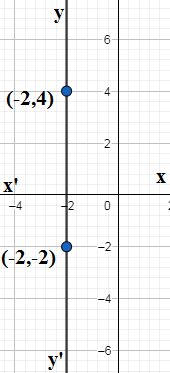
How do you find the slope given $\left( -2,-2 \right)$ and$\left( -2,4 \right)$? \[\]
Answer
544.5k+ views
Hint: We recall the definition of slope form slope of point equation. We use the formula for slope of line joining two points $\left( {{x}_{1}},{{y}_{1}} \right),\left( {{x}_{2}},{{y}_{2}} \right)$ that is $m=\dfrac{{{y}_{2}}-{{y}_{1}}}{{{x}_{2}}-{{x}_{1}}}$ to find the slope of line joining the given points $\left( -2,-2 \right)$ and$\left( -2,4 \right)$ .\[\]
Complete step-by-step solution:
We know from the Cartesian coordinate system that every linear equation can be represented as a line. If the line is inclined with positive $x-$axis at an angle $\theta $ then its slope is given by $m=\tan \theta $ and if it cuts $y-$axis at a distance $c$ from the origin the intercept is given by $c$. The slope-intercept form of equation is given by
\[y=mx+c\]
The slope $m$ here means rise over run which means to what extent the line raised itself above the positive $x-$axis with respect to the extension in the $x-$axis. If $m=0$ we get a line parallel to $x-$axis .We know that if the slope which undefined which means $m=\infty $ we get a line perpendicular to $x-$axis and if $m=0$ we get a line parallel to $x-$axis.\[\]
We know that when we are given a line joining two points $\left( {{x}_{1}},{{y}_{1}} \right),\left( {{x}_{2}},{{y}_{2}} \right)$ in plane then we can find the slope of the line as the ratio of horizontal range ${{y}_{2}}-{{y}_{1}}$ and vertical range ${{x}_{2}}-{{x}_{1}}$ which means
\[m=\dfrac{{{y}_{2}}-{{y}_{1}}}{{{x}_{2}}-{{x}_{1}}}\]
We are given the coordinates of two points $\left( -2,-2 \right)$ and$\left( -2,4 \right)$. So we have ${{x}_{1}}=-2,{{y}_{1}}=-2,{{x}_{2}}=-2,{{y}_{2}}=4$. So the slope of the line is
\[m=\dfrac{{{y}_{2}}-{{y}_{1}}}{{{x}_{2}}-{{x}_{1}}}=\dfrac{4-\left( -2 \right)}{-2-\left( -2 \right)}=\dfrac{6}{0}=\infty \]
So the slope is undefined and hence the line perpendicular to $x-$axis.

Note: We note that line passing given two points has the equation $x=-2$.The slope determines the orientation and inclination of the line. We note that if the slope is $m > 0$ positive then we get a line increasing from left to right. If the slope is negative that is $m < 0$ we get a line decreasing from left to right.
Complete step-by-step solution:
We know from the Cartesian coordinate system that every linear equation can be represented as a line. If the line is inclined with positive $x-$axis at an angle $\theta $ then its slope is given by $m=\tan \theta $ and if it cuts $y-$axis at a distance $c$ from the origin the intercept is given by $c$. The slope-intercept form of equation is given by
\[y=mx+c\]
The slope $m$ here means rise over run which means to what extent the line raised itself above the positive $x-$axis with respect to the extension in the $x-$axis. If $m=0$ we get a line parallel to $x-$axis .We know that if the slope which undefined which means $m=\infty $ we get a line perpendicular to $x-$axis and if $m=0$ we get a line parallel to $x-$axis.\[\]
We know that when we are given a line joining two points $\left( {{x}_{1}},{{y}_{1}} \right),\left( {{x}_{2}},{{y}_{2}} \right)$ in plane then we can find the slope of the line as the ratio of horizontal range ${{y}_{2}}-{{y}_{1}}$ and vertical range ${{x}_{2}}-{{x}_{1}}$ which means
\[m=\dfrac{{{y}_{2}}-{{y}_{1}}}{{{x}_{2}}-{{x}_{1}}}\]
We are given the coordinates of two points $\left( -2,-2 \right)$ and$\left( -2,4 \right)$. So we have ${{x}_{1}}=-2,{{y}_{1}}=-2,{{x}_{2}}=-2,{{y}_{2}}=4$. So the slope of the line is
\[m=\dfrac{{{y}_{2}}-{{y}_{1}}}{{{x}_{2}}-{{x}_{1}}}=\dfrac{4-\left( -2 \right)}{-2-\left( -2 \right)}=\dfrac{6}{0}=\infty \]
So the slope is undefined and hence the line perpendicular to $x-$axis.

Note: We note that line passing given two points has the equation $x=-2$.The slope determines the orientation and inclination of the line. We note that if the slope is $m > 0$ positive then we get a line increasing from left to right. If the slope is negative that is $m < 0$ we get a line decreasing from left to right.
Recently Updated Pages
Why are manures considered better than fertilizers class 11 biology CBSE

Find the coordinates of the midpoint of the line segment class 11 maths CBSE

Distinguish between static friction limiting friction class 11 physics CBSE

The Chairman of the constituent Assembly was A Jawaharlal class 11 social science CBSE

The first National Commission on Labour NCL submitted class 11 social science CBSE

Number of all subshell of n + l 7 is A 4 B 5 C 6 D class 11 chemistry CBSE

Trending doubts
What is meant by exothermic and endothermic reactions class 11 chemistry CBSE

10 examples of friction in our daily life

One Metric ton is equal to kg A 10000 B 1000 C 100 class 11 physics CBSE

1 Quintal is equal to a 110 kg b 10 kg c 100kg d 1000 class 11 physics CBSE

Difference Between Prokaryotic Cells and Eukaryotic Cells

What are Quantum numbers Explain the quantum number class 11 chemistry CBSE




